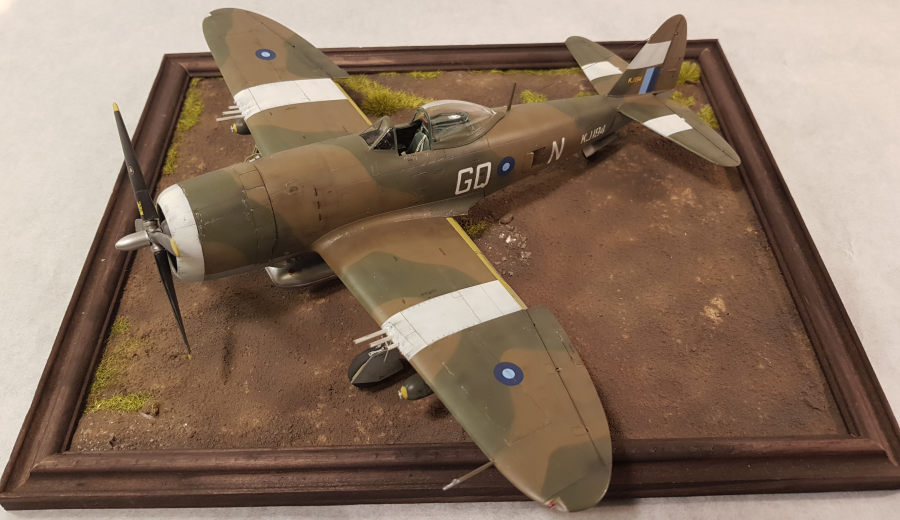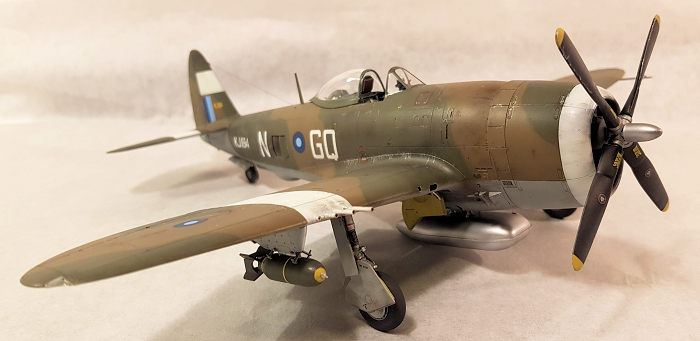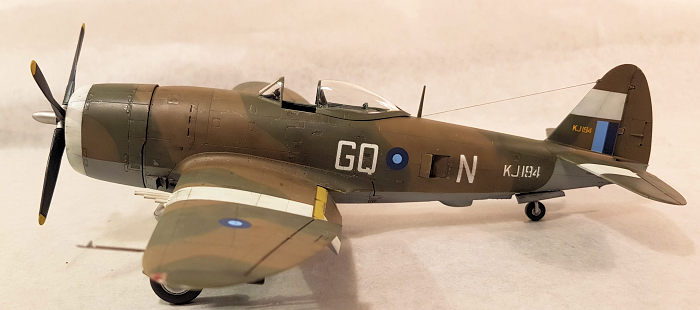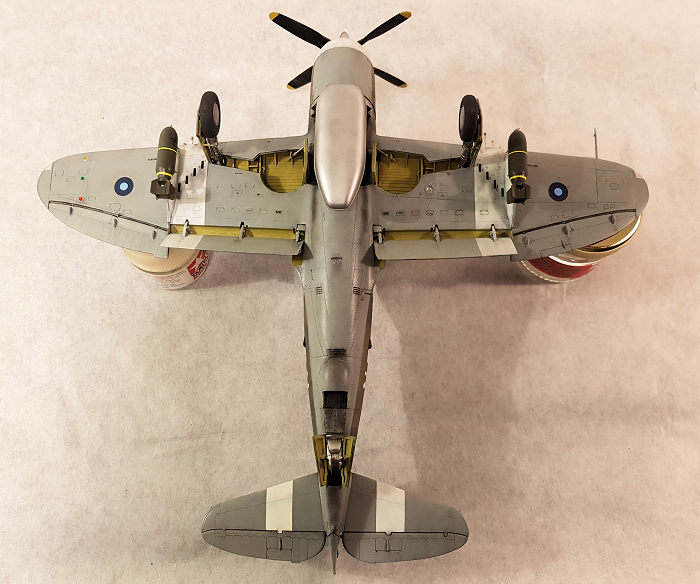
| KIT #: | 61090 |
| PRICE: | |
| DECALS: | |
| REVIEWER: | Fernando Rolandelli |
| NOTES: |

| HISTORY |
 No.134
Squadron was formed to take Hurricanes to the Soviet Union to help defend
Murmansk, before going on to serve in Northern Ireland, North Africa and Burma.
It was one of two squadrons that formed No.151 Wing, operating from Vaenga,
Murmansk, in September-October 1941. Then was reformed in North Ireland on
Spitfires, later embarking for Egypt in June 1942, flying Hurricanes.
No.134
Squadron was formed to take Hurricanes to the Soviet Union to help defend
Murmansk, before going on to serve in Northern Ireland, North Africa and Burma.
It was one of two squadrons that formed No.151 Wing, operating from Vaenga,
Murmansk, in September-October 1941. Then was reformed in North Ireland on
Spitfires, later embarking for Egypt in June 1942, flying Hurricanes.
The squadron reached India in November 1943, flying ground attack missions against the Japanese in the Arakan. In May 1944 began to reequip with Thunderbolts, being operational again in December. It supported the landings at Rangoon in April 1945. In June it returned to India where it was renumbered as No. 131 Sqn.
| THE KIT |
The Tamiya kit, #61090, is a typical flawless piece of engineering. It is however not so simple and the way assembly goes must be followed. It has s complete choice of external loads, three types of tanks, bombs and rocket launchers. Decals are a bit thick, and include the many ID squares and bands (good luck with them!), as well as a myriad of stencils. For completeness sake, I added an Eduard Zoom PE set, mainly for the dashboard and harness, but added some color to the cockpit.
| CONSTRUCTION |
 I
should say it was smooth, but the kit is complex and you must follow the
instructions; if you do, everything clicks in place. The engine is very visible
and well detailed, I added the customary ignition wires. The PE set includes
grilles for the intakes below the engine, but they are invisible after
everything is assembled. I finished the cockpit, adding the backs to the
instruments and painted it Dark Dull Green (mine is from the old WEMM line and
it is a bit dark; any Medium Green 42 or FS34092 will work); then added some
ducting towards the turbocharger exits. Fit of the wings is exemplary and the
dihedral is secured by the rear of the wheel wells which protrudes from the
fuselage (neat); the wells are correctly closed in square boxes. Some details
were added as oleos and cables. The spine looks as troublesome but it is not.
Very little putty was added anywhere. Beware the thing is big, even the
tailwheel assembly looks like a lorry (I am used to flimsy Spitfire or 109s
arrangements) Take care when building the flaps; the arms should be glued inside
the flaps halves before closing them (guess how I realized…); I thinned a bit
the mating surfaces to prevent a floating effect; the final result is near
perfect. Undercarriage should fit in the correct angle. Choose your favourite
external loads well before assembly, mind you. I wondered if fitting the bombs
or the big tanks and finally the fact that the sway braces are not used on the
latter (and I had already fitted them) made me decide for the bombs.
I
should say it was smooth, but the kit is complex and you must follow the
instructions; if you do, everything clicks in place. The engine is very visible
and well detailed, I added the customary ignition wires. The PE set includes
grilles for the intakes below the engine, but they are invisible after
everything is assembled. I finished the cockpit, adding the backs to the
instruments and painted it Dark Dull Green (mine is from the old WEMM line and
it is a bit dark; any Medium Green 42 or FS34092 will work); then added some
ducting towards the turbocharger exits. Fit of the wings is exemplary and the
dihedral is secured by the rear of the wheel wells which protrudes from the
fuselage (neat); the wells are correctly closed in square boxes. Some details
were added as oleos and cables. The spine looks as troublesome but it is not.
Very little putty was added anywhere. Beware the thing is big, even the
tailwheel assembly looks like a lorry (I am used to flimsy Spitfire or 109s
arrangements) Take care when building the flaps; the arms should be glued inside
the flaps halves before closing them (guess how I realized…); I thinned a bit
the mating surfaces to prevent a floating effect; the final result is near
perfect. Undercarriage should fit in the correct angle. Choose your favourite
external loads well before assembly, mind you. I wondered if fitting the bombs
or the big tanks and finally the fact that the sway braces are not used on the
latter (and I had already fitted them) made me decide for the bombs.
| COLORS & MARKINGS |
 I
wanted to build a RAF Burma camouflaged machine; I understand these were
delivered in ANA DGrey/DGreen camo, but were repainted in-theater with British
colours. Over the primer and preshading I started with the White ID bands, which
were duly masked. Then the MSG (I used a new Xtracolor tin, but the colour did
not convince me, too blue. I resorted to an old one, which was spot on) I then
painted the Dark Earth and had a similar problem! Too light, too greenish! I use
to trust Xtracolor blindly for RAF colours, but these let me down. Again, a
prehistoric tin was much better. No problems with the Dark Green, fortunately.
I
wanted to build a RAF Burma camouflaged machine; I understand these were
delivered in ANA DGrey/DGreen camo, but were repainted in-theater with British
colours. Over the primer and preshading I started with the White ID bands, which
were duly masked. Then the MSG (I used a new Xtracolor tin, but the colour did
not convince me, too blue. I resorted to an old one, which was spot on) I then
painted the Dark Earth and had a similar problem! Too light, too greenish! I use
to trust Xtracolor blindly for RAF colours, but these let me down. Again, a
prehistoric tin was much better. No problems with the Dark Green, fortunately.
I used the Tamiya decals for the stencils, and they were fine (I debated over putting them at all, considering that the plane was repainted; but I decided to do that, if only not to be called lazy) Aeromaster decals are technically very good… usually. In this case, the printing of the code letters had oversprayed, and a White halo was around the strokes. I cut the letters very carefully, and applied them even more carefully. It worked, though they could not be moved too much, so the alignment was not perfect. Accuracy wise, the serial numbers in photos appear invariable in Black, and I have never seen one repeated on the fin, but well, I have not seen a photo of this airframe.
| CONCLUSIONS |
I was hoping for a relaxed build and this was not so, just because it is big and complex, not because any fault in the fit of the kit. Circumstances with the paints and decals did not help.
The end result is very good and I am wholly satisfied with it. Man, it is BIG.
| REFERENCES |
“P-47 Thunderbolt”, Bert Kinzey, Detail and Scale,
“P-47 Walkaround”, Lou Drendel, Squadron Publication
“The Air War for Burma”, Christopher Shores
Fernando Rolandelli
3 December 2024
Copyright ModelingMadness.com. All rights reserved. No
reproduction in part or in whole without express permission.
If you would like your product reviewed fairly and
fairly quickly, please
contact
the editor
or see other details in the
Note to
Contributors.